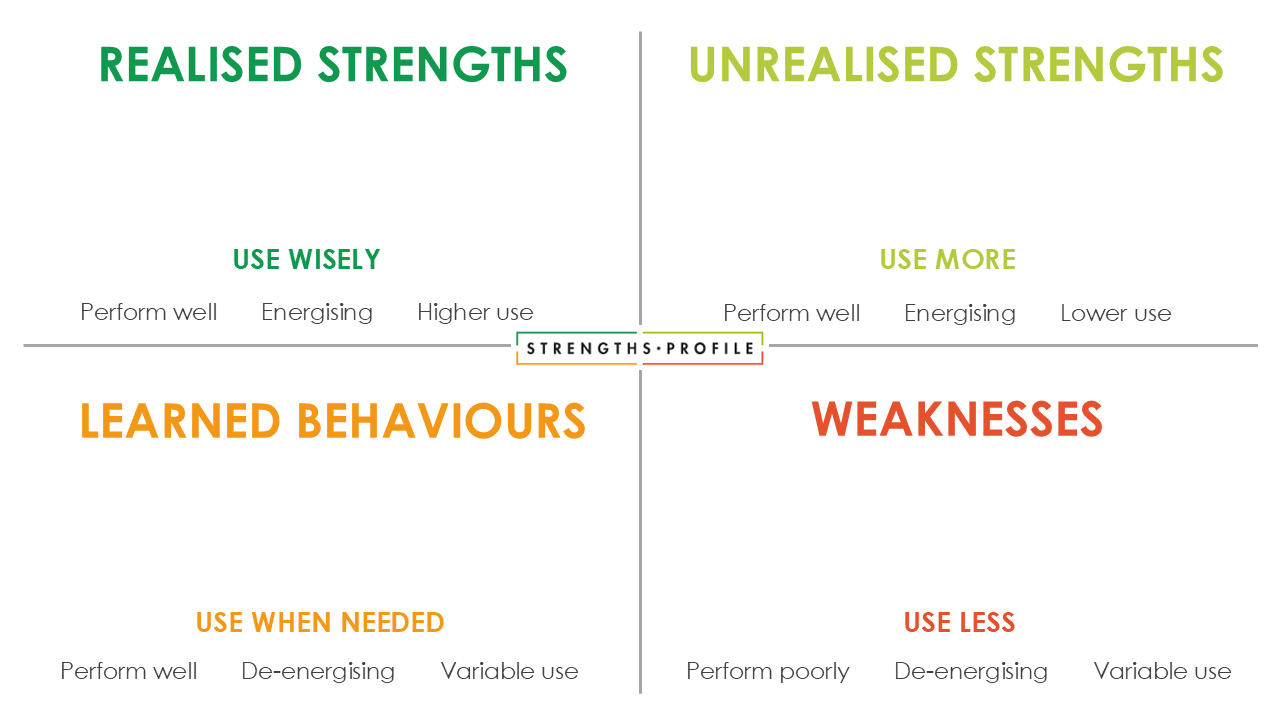
Retaking the Strengths Profile
Tips & Reflection Questions
Strengths Evolve – And That’s Okay!
The Strengths Profile report isn’t meant to be a static snapshot. Instead, it’s designed to capture where you are right now – in your work, life, mindset, and energy – and to help you reflect on the extent to which you’re actively tapping into the things that meet the three criteria of a ‘true’ strength:
Performance – You’re good at it and perform it well
Energy – It lights you up and energises you
Use – You choose to do it often, actively look for opportunities to apply it, and would happily do it more if you could!
These three elements are what give the Strengths Profile model its mobility – they explain why strengths can move between quadrants over time.
Below, I’ve shared a few things to keep in mind if you've retaken your profile and are looking over your results.
Change is Expected (and Encouraged)
Your strengths aren’t fixed. As your experiences and environment change, so too will your sense of what gives you energy, what you’re using regularly, and what you perform best.
That means movement between quadrants is not only normal – it’s encouraged. Growth, learning, shifting priorities, or taking on new responsibilities can all influence how your strengths ‘show up’ and where they land in your profile. Further down this page, you’ll find some insights and reflection questions to help you unpack any shifts you might see in your new, revised profile. It’s also okay if things don’t shift!
P.S. It’s worth noting that this isn't always the case for other strengths frameworks, with this idea of strengths “mobility” being quite unique to the Strengths Profile model.
Context Matters
Our use of strengths is deeply shaped by context – they’re influenced by your role, environment, workload, manager, and team dynamics. They can also be influenced by personal circumstances and the season of life you’re in.
As such, it’s common for profiles to shift when people move into a new environment, begin working on different types of tasks or activities, or experience significant life changes.
Retaking the profile gives you the opportunity to reflect on how different strengths might be ‘showing up’ in your current context, keeping these shifts in mind.
It’s Not Just a Repeat – It’s a Reset
Rather than spending too much time comparing results side-by-side, focus on what’s showing up now. What feels most relevant given your current situation? How might these insights help you to achieve short and long-term goals? Which strengths do you want to bring forth or ‘dial up’ more intentionally? Are there any you could potentially ‘overplay’ given the current context?
This fresh profile offers you a chance to check in on what’s changed in how you perform, where you get energy, and which strengths might be used most often.
What Might Changes Between Quadrants Tell You?
As you look at your latest profile, take a moment to notice what has shifted.
Changes in quadrant placement can reflect shifts in your role, your environment, your energy levels, or what you’ve chosen to focus on.
Here’s a quick guide to what those changes might mean, along with some reflection questions.
Please note that not every shift is covered, but instead the most likely ones.
Feel free to email me (Leisa) if you need some extra support!
Moved from Unrealised Strengths to Realised Strengths
You’ve brought something forward – you’re now actively using this strength more often while still feeling energised and capable when you do.
Becoming Realised means this strength is now being actively tapped into and leveraged in your day-to-day work.
This is usually a good thing!
Reflect on:
What has made it possible to start using this strength more often?
What impact has it had on your work or broader levels of wellbeing?
What value has this offered to others, the team, or the organisation more broadly?
How can you keep this strength visible and active?
Moved from Learned Behaviours to Realised Strengths
You may have found new energy in an area that once felt draining – or discovered a more aligned, enjoyable way of using this strength.
This shift might reflect a change in role, mindset, confidence, or context.
It could also mean you’ve built new habits that allow you to use the strength in a way that feels more natural and rewarding.
Reflect on:
What’s helped this strength become more energising for you?
How can you continue using it in a way that sustains that energy?
What difference has this shift made in how you approach your work?
Moved from Realised Strengths to Unrealised Strengths
You may still enjoy and perform well in this area – but you’re not using it as frequently at the moment.
This could be due to changes in your role, priorities, team, or workload.
While the strength is still energising and effective when used, it’s currently sitting in the background, waiting to be reactivated.
Reflect on:
What’s changed in your role or context that’s reduced your use of this strength?
Do you want to create more opportunities to use it again – or is it okay to leave it dormant for now?
Is this shift temporary, or does it reflect a longer-term change in direction?
You’re still doing this well and often – but it may no longer give you the same energy boost, or it might now feel more draining or taxing.
Learned Behaviours can still support strong performance – but that can come at a cost. They’re worth noticing so you can pace yourself and avoid burnout.
Moved from Realised Strengths to Learned Behaviours
Reflect on:
What’s changed in how this strength feels for you?
Does it feel draining or come with an energy ‘cost’? To what extent is it still required to achieve successful outcomes?
How can you best manage your energy when using this strength or these skills / behaviours?
Moved from Learned Behaviours to Weaknesses
This could suggest a perceived drop in performance. Previously, this wasn’t something that gave you energy, but you still felt capable when using it.
Now, it may feel more difficult, less effective, or simply not worth the effort – and it still doesn’t energise you. This shift can signal a strength that’s become harder to rely on or no longer fits your current role or focus.
Regardless of why this shift occurred, remember that the Strengths Profile philosophy would suggest using Weaknesses less, not more – unless they’re critical for your current role or goals.
Reflect on:
Has this strength become less relevant, or simply harder to perform well?
Do you want to invest in rebuilding it – or let it go?
Is this something you can start doing less of or delegate?
What other strengths could you lean on to achieve similar outcomes?
Moved from Learned Behaviours to Unrealised Strengths
You may have discovered new energy in a strength that once felt draining, or found a more aligned, enjoyable way of using it.
This suggests you now recognise the strength's potential, but it may not yet be applied consistently in your day-to-day life.
Further effort might be required to activate this strength regularly.
Reflect on:
What has made this strength feel more energising, even if you’re not using it regularly?
What’s getting in the way of applying it more consistently?
How can you start using this strength more frequently in your daily work?
Moved from Weaknesses to Any Other Quadrant
This shift suggests that something has changed – either in how you perceive your ability, or the energy you get from this activity.
For example, it may reflect growth if you’ve actively developed these skills due to role requirements (leading to an increase in performance).
While the Strengths Profile philosophy doesn’t recommend focusing on Weaknesses unless necessary, some movement can occur, especially if you’ve consciously chosen to work on skills that are essential to your role.
Reflect on:
What has changed – is it your performance, your energy, or perhaps both?
Was this shift intentional, or did it evolve over time?
Is this something you want to keep doing – or still something you’d prefer to use sparingly? Depending on where it has landed in your profile, consider how it fits with your role and current context.
Note: Some less common shifts haven’t been included. For example, a direct move from Realised Strengths to Weaknesses is quite rare, as it would suggest a significant decline across all three elements: performance, energy, and use. It’s more common to see strengths shift gradually through the Learned Behaviours or Unrealised Strengths quadrants before becoming a Weakness, if at all.




